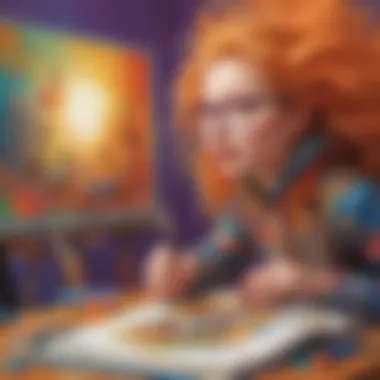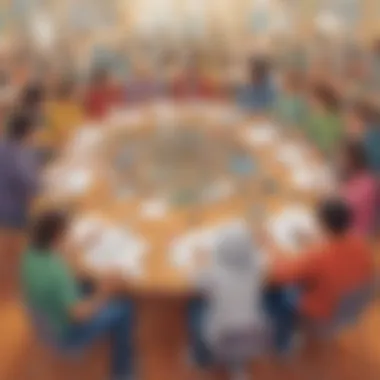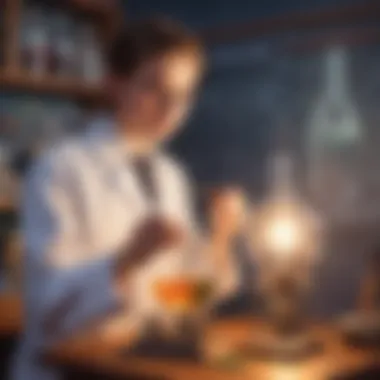Unlocking the Power of Creative Thinking in Students: Techniques and Inspiring Examples


Creative Activytes
For our young creative minds, engaging in craft projects can be an excellent way to foster imagination and innovation. By providing children with creative craft ideas, we are encouraging them to think outside the box and explore their artistic abilities. Craft ideas may range from simple paper crafts to more complex DIY projects using recyclable materials. These activities not only serve as a source of enjoyment but also promote cognitive development and fine motor skills. Children can create colorful artworks, personalize gifts, or even construct small structures using everyday items found at home.
- Craft Ideas: Embarking on projects such as making paper origami, creating handprint art, or designing homemade greeting cards can inspire children to think creatively and develop their artistic skills. These activities are not only fun but also educational, as they encourage problem-solving and enhance spatial awareness.
- Step-by-Step Guides: Offering detailed instructions for each craft activity ensures that children can follow along easily and complete the projects independently. Step-by-step guides simplify the crafting process, breaking it down into manageable steps that are easy to understand and execute.
- Educational Value: By engaging in creative craft projects, children can enhance their critical thinking skills, spatial reasoning, and cognitive abilities. Crafting fosters creativity, improves focus and concentration, and nurtures a sense of accomplishment in young learners.
Understanding Creative Thinking
Creative thinking holds a paramount position in the realm of education, serving as a catalyst for innovative ideas and solutions. In this article, we delve into the multifaceted nature of understanding creative thinking, shedding light on its crucial role in nurturing young minds. By exploring different facets of creative thinking, educators and parents can cultivate a fertile ground for intellectual growth and ingenuity, providing students with essential skills to thrive in an increasingly complex world.
Definition of Creative Thinking
Creative thinking encompasses divergent and convergent thinking processes, each offering distinct approaches to problem-solving and idea generation. Divergent thinking involves exploring multiple possibilities and brainstorming diverse solutions, fostering creativity and out-of-the-box thinking. On the other hand, convergent thinking focuses on narrowing down options to reach a specific solution, emphasizing critical analysis and decision-making. Understanding the interplay between divergent and convergent thinking is crucial for students to develop a well-rounded approach to tackling challenges effectively.
Importance in Education
Within the educational landscape, creative thinking plays a pivotal role in enhancing problem-solving skills. By nurturing a student's ability to think creatively, educators can empower them to approach complex problems with innovative solutions. This not only cultivates resilience and adaptability but also fosters a deeper understanding of real-world issues. Moreover, creative thinking encourages innovation by challenging students to explore unconventional ideas and contribute positively to their learning environment. By embracing creativity in education, students are better equipped to navigate uncertainty and drive positive change in society.
Examples of Creative Thinking in Students
Creative thinking is a vital skill that benefits students in numerous ways. By encouraging creative thought processes, students can enhance their problem-solving abilities, foster innovation, and develop a unique perspective on various subjects. In the context of this article, exploring examples of creative thinking in students sheds light on the importance of nurturing this skill from a young age. By providing students with opportunities to think outside the box and explore novel solutions, educators and parents can cultivate a generation of forward-thinkers primed to tackle future challenges.
Artistic Endeavors
Artistic endeavors play a crucial role in promoting creative thinking among students. When engaging in various art forms, students have the opportunity to express themselves, experiment with different mediums, and tap into their imagination. Exploring various art forms allows students to develop their artistic abilities, hone their creativity, and gain a deeper appreciation for the arts.
Exploring Various Art Forms


Exploring various art forms introduces students to a diverse range of artistic expressions, including painting, sculpting, music, and more. By delving into different forms of art, students can expand their creative horizons, discover new ways of self-expression, and cultivate an appreciation for aesthetics. This exposure to various art forms not only broadens students' artistic skills but also fosters a sense of cultural awareness and sensitivity.
Recycled Materials
Using Recycled Materials
Utilizing recycled materials in artistic endeavors promotes eco-consciousness and innovation among students. By repurposing materials such as paper, plastic, or fabric, students learn the value of sustainability and resourcefulness. Working with recycled materials also encourages students to think creatively, as they explore unconventional ways to create art while minimizing waste.
Scientific Curiosity
Scientific curiosity is another avenue through which students can exercise their creative thinking skills. By actively engaging in experiments and hypothesis development, students learn to approach problems methodically, think critically, and explore the unknown. Encouraging scientific curiosity in students instills a sense of wonder, encourages exploration, and nurtures a passion for discovery.
Conducting Experiments
Conducting experiments allows students to apply the scientific method, make observations, and draw conclusions based on evidence. Through hands-on experimentation, students develop critical thinking skills, problem-solving abilities, and a deeper understanding of scientific concepts. The process of conducting experiments not only cultivates creativity but also instills a sense of curiosity and exploration in students.
Developing Hypotheses
Developing hypotheses prompts students to make educated guesses, formulating ideas based on existing knowledge and observations. This process of hypothesizing encourages students to think analytically, make logical connections, and explore alternative perspectives. By fostering the development of hypotheses, educators empower students to engage with scientific inquiry in a meaningful and creative way.
Innovative Problem-Solving
Innovative problem-solving is a cornerstone of creative thinking in students. By encouraging students to devise new solutions and think outside the box, educators challenge them to explore unconventional approaches to problem-solving. This process develops students' resilience, adaptability, and ingenuity, preparing them to address complex issues confidently.
Creating New Solutions
Creating new solutions involves brainstorming, experimentation, and iteration to arrive at innovative outcomes. By encouraging students to generate fresh ideas and implement novel approaches, educators foster a culture of innovation and creativity. The process of creating new solutions not only expands students' problem-solving skills but also cultivates their confidence in tackling challenges creatively.


Thinking Outside the Box
Thinking outside the box encourages students to break free from traditional frameworks and explore alternative perspectives. This creative approach to problem-solving prompts students to challenge conventions, embrace ambiguity, and seek unconventional solutions. By thinking outside the box, students develop a sense of openness, adaptability, and creativity necessary for navigating the complexities of the modern world.
Techniques to Enhance Creative Thinking
Techniques to Enhance Creative Thinking play a vital role in fostering creative thinking in students. By implementing these techniques, educators can enable students to develop innovative solutions to problems and think outside the box effectively. The incorporation of diverse techniques ensures a holistic approach towards nurturing creativity. Considerations about Techniques to Enhance Creative Thinking include adaptability to different learning styles, promoting critical thinking skills, and fostering a growth mindset among students. These techniques equip students with the necessary tools to approach challenges creatively and cultivate a mindset conducive to problem-solving through innovation.
Encouraging Playfulness
Engaging in Role-Play
Engaging in Role-Play offers students a dynamic way to explore various perspectives and scenarios. This interactive technique allows students to immerse themselves in different roles, promoting empathy and enhancing communication skills. The key characteristic of Engaging in Role-Play lies in its ability to stimulate creativity and critical thinking simultaneously. By stepping into diverse roles, students can broaden their understanding of various situations, enhancing their problem-solving abilities. Engaging in Role-Play offers a hands-on approach to learning, encouraging active participation and creativity in a structured environment.
Utilizing Creative Toys
Utilizing Creative Toys provides students with tangible tools to express their creativity. These toys serve as instruments for imaginative play, enabling students to experiment, design, and create in a hands-on manner. The key characteristic of Utilizing Creative Toys is their versatility in stimulating multiple senses and fostering exploration. Creative toys open avenues for students to develop spatial awareness, fine motor skills, and imaginative thinking. While Utilizing Creative Toys offers numerous advantages in promoting creativity, the potential drawback lies in dependency, emphasizing the importance of balancing toy usage with other creative activities.
Promoting Exploration
Field Trips to Inspiring Locations
Field Trips to Inspiring Locations provide students with real-world experiences that ignite curiosity and inspire creativity. These trips offer a sensory-rich environment for students to observe, question, and learn beyond the classroom setting. The key characteristic of Field Trips to Inspiring Locations is the exposure to new stimuli that stimulate creativity and critical thinking. By stepping out of familiar surroundings, students can expand their perspectives and develop a deeper appreciation for diverse contexts. While Field Trips to Inspiring Locations offer significant benefits in sparking creativity, logistical challenges and safety considerations warrant detailed planning and supervision.
Hands-On Learning Experiences
Hands-On Learning Experiences engage students in active participation and practical applications of knowledge. This hands-on approach allows students to experiment, make mistakes, and learn through experience. The key characteristic of Hands-On Learning Experiences is the immediate feedback and real-time engagement that enhance retention and understanding. Through hands-on activities, students develop problem-solving skills, creativity, and a deeper understanding of concepts. While Hands-On Learning Experiences significantly benefit student learning, effective implementation requires careful planning, resource management, and alignment with learning objectives.


Embracing Failure as a Learning Opportunity
Resilience and Growth Mindset
Resilience and Growth Mindset instill in students the capacity to bounce back from setbacks and view challenges as opportunities for growth. These aspects foster perseverance, adaptability, and a positive approach towards learning. The key characteristic of Resilience and Growth Mindset is building inner strength and equipping students with the resilience to face uncertainties. By embracing failure as a learning opportunity, students develop emotional intelligence, self-awareness, and problem-solving skills. While Resilience and Growth Mindset offer significant advantages in personal development, instilling these attributes requires consistent support, encouragement, and feedback mechanisms.
Iterative Problem-Solving
Iterative Problem-Solving encourages students to approach challenges iteratively, refining solutions through multiple attempts. This method emphasizes the process of problem-solving over immediate results, nurturing perseverance and analytical thinking. The key characteristic of Iterative Problem-Solving is the focus on continuous improvement and adaptation to feedback. By engaging in iterative problem-solving, students enhance their critical thinking skills, creativity, and resilience in the face of obstacles. While iterative problem-solving is beneficial in fostering a growth mindset, time constraints and resource limitations can pose challenges in its application.
Integration into Education
As we delve into the core of nurturing creative thinking in students, one cannot overlook the vital role of integration into education. This section serves as the anchor point where educational philosophy converges with practical application. By intertwining creative thinking with traditional academic disciplines, educators pave the path for holistic learning journeys. The transformational power lies in how students perceive knowledge - not as discrete silos but as an interconnected web of possibilities waiting to be explored.
Curriculum Development
Designing Creative Assignments
Designing Creative Assignments within the curriculum formulation is like adding spice to a sumptuous dish. It injects vibrancy and innovation into the learning process, challenging students to think beyond rote memorization. Through these assignments, learners unleash their imaginative prowess, fostering a mindset that embraces innovation and ingenuity. One key characteristic of Designing Creative Assignments is their ability to transcend conventional boundaries, encouraging students to approach problems from multiple perspectives. This approach not only boosts critical thinking but also nurtures a sense of ownership and pride in one's work.
Incorporating Artistic Elements
Incorporating Artistic Elements into the educational landscape enriches the tapestry of learning experiences. Art, in its myriad forms, serves as a catalyst for self-expression and creativity. By infusing artistic elements into various subjects, educators cultivate a dynamic ecosystem where students can explore the intersection of aesthetics and academia. The unique feature of incorporating artistic elements is its ability to blend emotion with intellect, forging profound connections between abstract concepts and real-world applications. While this approach enhances engagement and cognitive flexibility, it also demands careful consideration to ensure a harmonious balance between artistry and academics.
Teacher Training
Professional Development Workshops
The cornerstone of educator growth, Professional Development Workshops offer a valuable platform for enhancing teaching practices that foster creative thinking. These workshops equip teachers with innovative strategies, pedagogical insights, and collaborative opportunities essential for cultivating a creative learning environment. A key characteristic of Professional Development Workshops is their emphasis on continuous learning and adaptation, aligning teaching methodologies with contemporary educational trends. By actively participating in these workshops, educators can refine their instructional techniques, ultimately empowering students to thrive in a dynamic learning landscape.
Creative Thinking Pedagogy
At the helm of progressive education lies Creative Thinking Pedagogy, a guiding principle that champions divergent thought and experiential learning. This pedagogical approach emphasizes exploration, experimentation, and reflection as foundations for knowledge construction. The unique feature of Creative Thinking Pedagogy is its student-centered nature, encouraging learners to take ownership of their learning journey. By fostering a culture of curiosity and resilience, this pedagogy instills self-confidence and adaptability in students, preparing them for the complexities of the 21st-century world. While celebrating creativity and innovation, Creative Thinking Pedagogy requires educators to nurture an environment that values intellectual risk-taking and growth mindset.







